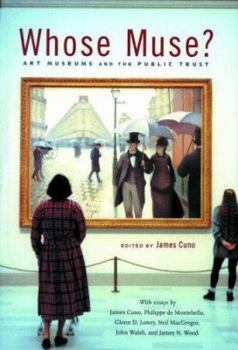Whose Muse?: Art Museums and the Public Trust
Select Format
Select Condition 
Book Overview
During the economic boom of the 1990s, art museums expanded dramatically in size, scope, and ambition. They came to be seen as new civic centers: on the one hand as places of entertainment, leisure, and commerce, on the other as socially therapeutic institutions. But museums were also criticized for everything from elitism to looting or illegally exporting works from other countries, to exhibiting works offensive to the public taste.
...
Format:Paperback
Language:English
ISBN:0691127816
ISBN13:9780691127811
Release Date:October 2006
Publisher:Princeton University Press
Length:208 Pages
Weight:0.90 lbs.
Dimensions:0.5" x 6.0" x 9.1"
Customer Reviews
2 ratings
Whose Museum Is It Anyway?
Published by Thriftbooks.com User , 16 years ago
With everything from motorcycles, cars, boats, Jackie O's clothes, Star Wars artifacts, elephant dung and more finding their way into the museum, this is probably a good time to examine just what the museum is and who it is for. Art Institute of Chicago director James Cuno has assembled a veritable who's who of major museum directors to hold forth on this topic. Taken together, the essays provide rare insight into how museums are being shaped in the 20th century. With sometimes surprising candor the directors make their case for how and why the museum is beholden to the public trust. A roundtable discussion at the book's end further amplifies the issues set forth in the essays. This is an important book.
Not a boring subject!
Published by Thriftbooks.com User , 17 years ago
This is a compilation of essays written by directors of major art museums: Cuno from the Art Institute of Chicago, De Montebello from the Met, Lowry from the MoMA, MacGregor from the British Museum, Walsh of the Getty in LA, and Wood, formerly of the AIC. Each addresses how museums can cultivate public trust in cultural institutions, the kinds of authority museums have, and how they should manage their responsibilities. MacGregor's essay was my personal favorite; it includes two amazing stories of how art proves to be valued for its emotional power during times of crisis (specifically on 9/11 and during WWII). Walsh offers suggestions as to how museums can offer its visitors a more genuine experience through curatorial choices and placement of lighting and seats. Lowry and De Montebello write about the relationship of the entertainment industry to museums. A very accessible, jargon-free text that is surprisingly interesting.




